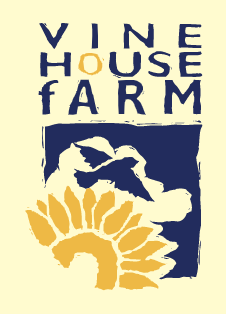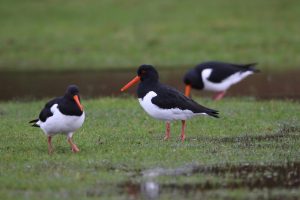
No records broken this month. August was warmer and wetter than average. I recorded 67mm/2.6 ins of rain and the average temperature was 18ºC.

The wheat harvest was finished earlier than usual, and despite yields being down on our gravelly land they were on average with the last five years. It was of a good quality, due to all the sunshine we had in June and July.
Our sunflower fields looked spectacular when they were in flower and we had good coverage of them on ITV Anglia, BBC Look North, the Daily Mail and on the Good Morning Britain weather forecast. They had a good dose of sunshine when in flower, so hopefully we will have a good crop.
Our next crop for harvesting will be the organic red clover, followed by the canary seed, the red millet, the white millet and lastly the sunflowers. All these crops have been able to benefit from the rain since the drought has broken, along with the sugar beet and the potatoes.
The potatoes have been very hard work this year. We have irrigated them non stop but they didn’t grow in the hot dry weather. We did keep them alive and they are now enjoying the cooler weather and are putting on some weight.
Harvest time is the most important time of year, where we find out what our crops have yielded and to determine which crops, and their varieties, we will grow next year. Due to modern technology the combine can tell us how much each crop has yielded, whereas 20 years ago we would’ve had to estimate the yield. Throughout the country there are trial grounds recording the yields of all combinable crops, including existing and new varieties. This information is available to farmers which helps us to decide what varieties to grow for the following harvest.
Not every crop will show a profit every year but wheat is the best all round crop for most land types. We don’t grow it every year, or in every field, because we have to have a rotation. Most farmers have narrowed their rotation, growing only the two crops that pay the best, usually wheat and oil seed rape. This has done them very well for many years, but they have now run into trouble with a grass weed called Blackgrass.
Blackgrass is a plant that produces 10,000 seeds and only 0.01% need to survive to cause havoc in our crops. It is an autumn germinating plant which likes to start growing when oil seed rape and winter wheat are sown. Spring sown crops help to naturally control weeds so farmers have now started growing spring barley, peas and sugar beet again to avoid Blackgrass, and improve crop rotations. These crops are less profitable, however, so farmers have a dilemma.
We grow wheat every other year on our farm and the yield always depends on the crop preceding it. There is a large difference on the profitability of these alternate crops – oil seed rape is usually the most profitable crop after wheat, which is why there is so much of it grown. It is also the best crop for birds, as more birds feed in it and nest in it than any other crop, but unfortunately, that’s not of high importance to many farmers.


The breeding season is now over for all birds that use insects to feed their young. Only the Wood Pigeons and Stock Doves are able to continue to breed. Every bird must take their young moist food, as they can’t take them water. The moist food, as far as the Dove family is concerned, is pigeon milk which their digestive system makes after the adult has eaten grain and taken on water. They only lay two eggs because their digestive system will only produce enough pigeon milk for one youngster, therefore two adults can feed two youngsters. With some species, the female does all the feeding of the young but both pigeon parents have to work hard to raise the family.
Generally, the farm is fairly quiet as far as bird song is concerned but the farm yard is not quiet. I hear a Robin singing wherever I go around the yard. I have been feeding mealworms for several years which has built up a good population of Robins and House Sparrows. The Pied Wagtails have been taking a lot of mealworms during the year but they didn’t rear any young – the nests failed, possibly due to visiting cats.
If we want to see a lot of birds we have to breed a lot of birds and studies have shown that by feeding live mealworms you will rear 60% more birds in your garden. When we look at those birds that are declining, they are birds that do not come into gardens – the true farmland birds. We are running out of insects and nearly everyone is at war with them. They itch, they sting, some are noisy, can give us and our farm animals diseases and can make the food we eat inedible. No wonder everyone is at war with them but they are the basis of life. Could we survive without them? Experts say no, we couldn’t. If that is so, what is our future?
Tree Sparrows have bred well, but as I have now saturated the farm with nest boxes I will be erecting nest boxes on other farmers land where there is suitable habitat. Suitable habitat is where there is an area of ground not growing a crop, with plenty of insects, water and plant diversity.
Out in the Fenland countryside there are a lot of nasty plants such as nettles, thistles, docks and others you wouldn’t want in your garden. Grasses do provide insects, but not nearly so many as broad leaved plants. Wheat is a grass plant, rape is a broad leaved plant, which is why rape is the best crop for wildlife closely followed by peas and beans. Broad leaved plants have prominent flowers, attracting insects that birds need to feed their young. Grasses do flower, but the flowers are so insignificant that you can hardly see them.
TALKS & events
Thursday 4th October Corby Glen W.I.
The Church Street Rooms, Corby Glen
Saturday 20th October Cheshire Wildlife Trust
AGM, Quarry Bank Mill, Wilmslow



